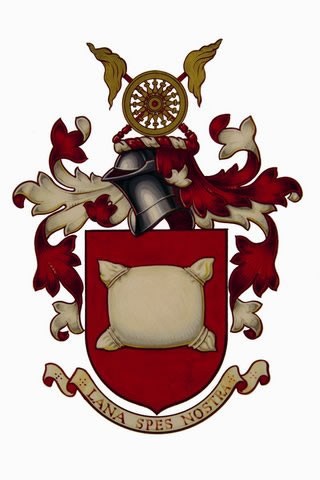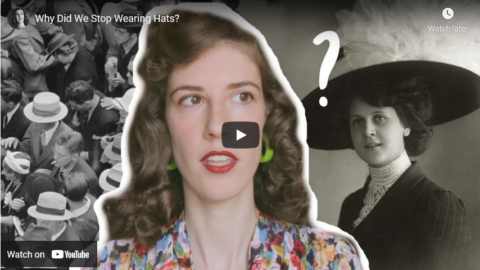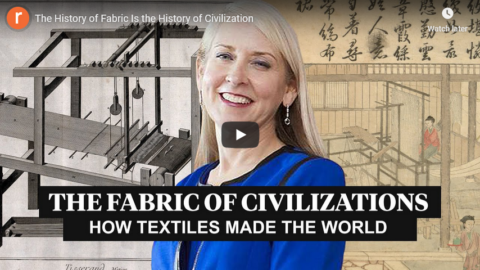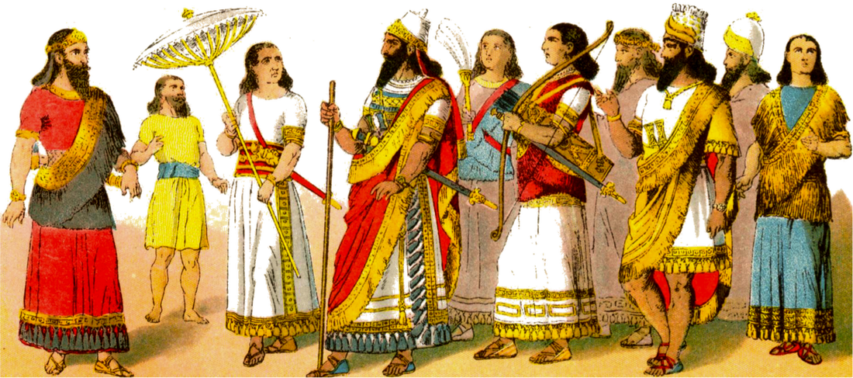Karolina Żebrowska
Published 28 Apr 2020should we bring hats back? what do you think?
_____________
My Instagram: https://bit.ly/2Qo9rrI
My nudes: https://bit.ly/2UHHY6N
My merch: bit.ly/2CCq5jE
May 19, 2021
Why Did We Stop Wearing Hats?
April 30, 2021
Period drama costume designers these days
Karolina Żebrowska
Published 15 Aug 2019Piero Tosi died last week and it made me really sad. he was one of the first to understand how staying close to history can actually make the film costumes fascinating, not boring. sadly, I’m beginning to think he was also one of the last — today’s mainstream cinema is all about “making things relatable for the modern viewer”.
________
My Instagram: https://bit.ly/2Qo9rrI
My nudes: https://bit.ly/2KypPpn
My merch: bit.ly/2CCq5jE
December 13, 2020
How the Romans Stole Silk Production Secrets from China
Kings and Generals
Published 31 Jan 2019Go to https://www.wix.com/KingsAndGenerals to get started on your website today!
Check out our new website at http://kingsandgenerals.orgSilk production was one of the biggest secrets of China and one of the most lucrative industries of the age. So it is not a surprise that the Roman emperor Justinian was eager to learn this secret. In this video we will discuss the start of the silk production, its importance and the story of how Justinian managed one of the first industrial thefts in history
Support us on Patreon: http://www.patreon.com/KingsandGenerals or Paypal: http://paypal.me/kingsandgenerals
Check out our Merch Store: teespring.com/stores/kingsandgenerals
We are grateful to our patrons and youtube members, who made this video possible: https://drive.google.com/open?id=1Xa-…
The video was made by our friend Cogito
This video was narrated by Officially Devin (https://www.youtube.com/user/Official…)
Merch store ► teespring.com/stores/kingsandgenerals
Podcast ► Google Play: http://bit.ly/2QDF7y0 iTunes: https://apple.co/2QTuMNG
Twitter ► https://twitter.com/KingsGenerals
Instagram ► http://www.instagram.com/Kings_Generals
Production Music courtesy of Epidemic Sound: http://www.epidemicsound.com
#Documentary #Justinian #Silk
November 24, 2020
The History of Fabric Is the History of Civilization
ReasonTV
Published 23 Nov 2020Virginia Postrel’s new book explores economics, politics, and technology through textiles.
——————
Full text and links: https://reason.com/video/2020/11/23/t…Follow us on Twitter: https://twitter.com/reason
Reason is the planet’s leading source of news, politics, and culture from a libertarian perspective. Go to reason.com for a point of view you won’t get from legacy media and old left-right opinion magazines.
—————-The Fabric of Civilization: How Textiles Made the World, a new book by former Reason editor in chief Virginia Postrel, is a rich, endlessly fascinating history of the remarkable luck, invention, and innovation that made our fabric-rich world possible.
The book aims to make the mundane miraculous. Consider cotton. Most of the cotton we grow today is descended in part from a plant species that evolved in Africa and somehow got over to what is now Peru, where it mixed with New World strains.
“The fact that we have cotton at all, that it exists anywhere, is amazing,” says Postrel. “It happened long before there were human beings, but much more recently than when the continents were together. So we don’t know. It could have gotten caught up in a hurricane. It could have floated on a piece of pumice. So it’s this random, very unlikely happening that had tremendous world-changing consequences.”
The story of textiles is rife with attempts at protectionism and prohibition. In 17th and 18th century Europe, countries banned the importation of super-soft, super-colorful cotton prints from India known as calicos because they threatened domestic producers of everything from lower-quality cotton fabric to luxury silks. “For 73 years, France treated calico the way the U.S. treats cocaine,” Postrel says. “There was this huge amount of smuggling, and they were constantly ratcheting up the penalties [so] that they got quite grotesque, at least for the major traffic.” Some of “the earliest writings of classical liberalism are in this context, people saying not only is this not working, but … it is unjust to be sentencing people to the galleys in order to protect silk makers’ profits.”
Postrel also documents how the Luddites, the 19th century English textile workers famous for smashing the power looms threatening to put them out of work, owed their jobs to an earlier technological breakthrough: the spinning machines that emerged in the late 1700s.
“If you go back to that earlier period, when spinning machines were introduced, the same thing happened,” she says. “They had their own period of rebelling against the new technologies and saying they’re putting people out of work.”
The book also upends some contemporary myths, such as the claim that commercial production of hemp for clothing was a casualty of the war on drugs. “Hemp historically was a very coarse kind of fabric for poor people who didn’t have an alternative,” says Postrel. “It was replaced by cotton for good reasons. Cotton was also affordable, but it was soft and washable and just a much better fabric.”
“Human beings live in history and we inherit the legacies, positive and negative, of that history,” says Postrel, whose previous books include The Power of Glamour, The Substance of Style, and The Future and Its Enemies. Discussing the large themes of her work she says, “All you can do is start from where you are and try to do better from where you are.”
Narrated by Nick Gillespie. Edited by Isaac Reese.
Music: “Thoughts,” by ANBR
Photos: World History Archive/Newscom; The Print Collector Heritage Images/Newsroom; The “Réale” returning to port, Med/CC BY-SA 3.0; Smithsonian National Museum of African American History and Culture/CC0; Battle of Grand Port, Rama/Wikimedia Commons/CC BY-SA 2.0 FR; Fine Art Images Heritage Images/Newscom; Seton, M., Müller, R., Zahirovic, S., Gaina, C., Torsvik, T., Shephard, G., Talsma, A., Gurnis, M., Turner, M., Maus, S., and Chandler, M., 2012, Global continental and ocean basin reconstructions since 200 Ma: Earth-Science Reviews, v. 113, no. 3-4, p. 212-270
November 15, 2020
London’s wool and cloth trade fuelled massive growth in the city’s population after 1550
In the latest Age of Invention newsletter, Anton Howes traces the rise and fall of the late Medieval wool trade and its rebirth largely thanks to an influx of Dutch and Flemish clothmakers fleeing the wars in the Low Countries after 1550:

The Coat of Arms of The Worshipful Company of Woolmen — On a red background, a silver woolpack, with the addition of a crest on a wreath of red and silver bearing two gold flaxed distaffs crossed like a saltire and the wheel of a gold spinning wheel.
The Worshipful Company of Woolmen is one of the Livery Companies in the City of London. It is known to have existed in 1180, making it one of the older Livery Companies of the City. It was officially incorporated in 1522. The Company’s original members were concerned with the winding and selling of wool; presently, a connection is retained by the Company’s support of the wool industry. However, the Company is now primarily a charitable institution.
The Company ranks forty-third in the order of precedence of the Livery Companies. Its motto is Lana Spes Nostra, Latin for Wool Is Our Hope.
Wikipedia.
… it was one thing to be able to reach these new southern markets, and another thing to have something to sell in them. For the shift in the markets for wool cloth exports also required major changes in the kinds of cloth produced. In this regard, London may well have been a direct beneficiary of the 1560s-80s troubles in the Low Countries that had caused Antwerp’s fall, because thousands of skilled Flemish and Dutch clothmakers fled to England. In particular, these refugees brought with them techniques for making much lighter cloths than those generally produced by the English — the so-called “new draperies”, which could find a ready market in the much warmer Mediterranean climes than the traditional, heavy woollen broadcloths.
The introduction of the new draperies was no mere change in style, however. They were almost a completely different kind of product, involving different processes and raw materials. The traditional broadcloths were “woollens”. That is, they were made from especially fine, short, and curly wool fibres — the type that English sheep were especially famous for growing — which were then heavily greased in butter or oil in preparation for carding, whereby the fibres were straightened out and any knots removed (because of all the oil, in the Low Countries the cloths were known as the wet, or greased draperies). The oily, carded wool was then spun into yarn, and typically woven into a broad cloth about four metres wide and over thirty metres long. But it was still far from ready. The cloth had to be put in a large vat of warm water, along with some urine and a particular kind of clay, and was then trodden by foot for a few days, or else repeatedly compacted by water-powered machinery. This process, known as fulling, scoured the cloth of all the grease and shrunk it, compacting the fibres so that they began to interlock and enmesh. Any sign of the cloth being woven thus disappeared, leaving a strong, heavy, and felt-like material that was, as one textile historian puts it, “virtually indestructible”. To finish, it was then stretched with hooks on a frame, to remove any wrinkles and even it out, and then pricked with teasels — napped — to raise any loose fibres, which were then shorn off to leave it with a soft, smooth, sometimes almost silky texture. Woollens may have been made of wool, but they were no woolly jumpers. They were the sort of cloth you might use today to make a thick, heavy and luxuriant jacket, which would last for generations.
Yet this was not the sort of cloth that would sell in the much warmer south. The new draperies, introduced to England by the Flemish and Dutch clothworkers in the mid-sixteenth century, used much lower-quality, coarser, and longer wool. Later generally classed as “worsteds”, after the village of Worstead in Norfolk, they were known in the Low Countries as the dry, or light draperies. They needed no oil, and the long fibres could be combed rather than carded. Nor did they need any fulling, tentering, napping, or shearing. Once woven, the cloth was already strong enough that it could immediately be used. The end product was coarser, and much more prone to wear and tear, but it was also much lighter — just a quarter the weight of a high-quality woollen. And the fact that the weave was still visible provided an avenue for design, with beautiful diamond, lozenge, and other kinds of patterns. The new draperies, which included worsteds and various kinds of slightly heavier worsted-woollen hybrids, as well as mixes with other kinds of fibre like silk, linen, Syrian cotton, or goat hair, thus came in a dazzling number of varieties and names: from tammies or stammets, to rasses, bays, says, stuffs, grograms, hounscots, serges, mockadoes, camlets, buffins, shalloons, sagathies, frisadoes, and bombazines. To escape the charge that the new draperies were too flimsy and would not last, some varieties were even marketed as durances, or perpetuanas.
Curiously, however, while the shift from woollens to worsted saved on the costs of oiling, fulling, and finishing, it was significantly more labour-intensive when it came to spinning — even resulting in a sort of technological reversion. Given the lack of fulling, the strength of the thread mattered a lot more for the cloth’s durability, and the yarn had to be much finer if the cloth was to be light. The spinning thus had to be done with much greater care, which made it slower. Spinners typically gave up using spinning wheels, instead reverting to the old method of using a rock and distaff — a technique that has been used since time immemorial. Albeit slower, the rock and distaff gave them more control over the consistency and strength of the ever-thinner yarn. For the old, woollen drapery, processing a pack of wool into cloth in a week would employ an estimated 35 spinners. For the new, lighter worsted drapery it would take 250. As spinning was almost exclusively done by women, the new draperies provided a massive new source of income for households, as well as allowing many spinsters or widows to support themselves on their own. Indeed, an estimated 75% of all women over the age of 14 might have been employed in spinning to produce the amounts of cloth that England exported and consumed. Some historians even speculate that by allowing women to support themselves without marrying, it may have lowered the national fertility rate.
This spinning, of course, was not done in London. It was largely concentrated in Norfolk, Devon, and the West Riding of Yorkshire. But the new draperies provided employment of another, indirect kind. As a product that was saleable in warmer climes it could be exchanged for direct imports of all sorts of different luxuries, from Moroccan sugar, to Greek currants, American tobacco (imported via Spain), and Asian silks and spices (initially largely imported via the eastern Mediterranean). The English merchants who worked these luxury import trades were overwhelmingly based in London, and had often funded the voyages of exploration and embassies to establish the trades in the first place, putting them in a position to obtain monopoly privileges from the Crown so that they could restrict domestic competition and protect their profits. Unsurprisingly, as they imported everything to London, it also made sense for them to export the new draperies from London too.
Thus, despite losing the concentrating influence of nearby Antwerp, London came to be the principal beneficiary of England’s new and growing import trades, allowing it to grow still further. The city began to carve out a role for itself as Europe’s entrepôt, replacing Antwerp, and competing with Amsterdam, as the place in which all the world’s rarities could be bought (and from which they could increasingly be re-exported). Indeed, English merchants were apparently happy to sell wool cloth at below cost-price in markets like Spain or Turkey — anything to buy the luxury wares that they could monopolise back home.
October 31, 2020
Modern Halloween costumes show us how wealthy we have become
Richard Lorenc looks back at the “costumes” for Halloween from the 1970s and 1980s to help illustrate how much our general economic picture has improved since those dark days:
While my husband and I were recently struggling to figure out our costumes for this Halloween (and we still don’t have any idea), he pulled up some old commercials on YouTube. The off-the-shelf options that trick or treaters had were, in a word, pitiful.
Basically, costume makers thought it was ok to make a front-only plastic mask (in any color, really) of a character and top it off with a plastic smock featuring an illustration of said character with either its name or the name of the show or movie it comes from. There was no attempt to dress in the character’s actual attire. If you wanted that, you’d either have to know a professional costumer or cobble together something from your closet.
Take a look for yourself at just how costume-poor we used to be:
Obviously, every costume is an opportunity to generate interest in a brand or franchise, and slapping on a logo is an easy way to get a name out there, but these costumes truly heralded a dark time for Halloween. Some may even argue that it demonstrated crass consumerism at its worst, with cynical companies taking the easiest route to grabbing a couple of bucks from desperate parents.
The truth of the tragedy of terrible old Halloween costumes has to do with a simple idea: specialization.
[…]
The next time you compare our screen-accurate store-bought costumes of Darth Vader and Mr. Incredible to those of yesteryear, remember that we enjoy them today not because previous generations didn’t care for accurate costuming, but because growing trade across the globe has generated so much wealth for each of us that we can now demand things we may have only imagined previously.
I only realized as I got ready to schedule this post that it was an article I’d blogged a couple of years back, but the point of the story is still relevant even in our pandemic-wracked economy of 2020.
October 14, 2020
“For Generation Z — roughly speaking, those born between 1995 and 2010 — ‘flattering’ is becoming a new F-word”
Hannah Betts explains why it’s now somewhere between awkward and mortally offensive to use the word “flattering” to or about a member of Gen Z:
Why do we wear clothes? The mundane answer runs “for protection against the elements”, pointing to the succession of Ice Ages to which homo sapiens was subjected, forced to borrow fur from more hirsute species.
Well, up to a point, Lord Copper. The ancient civilisations that grew up in the fertile valleys of the Euphrates, the Nile and the Indus, were more tropical than a Wham! video, and clearly using their outfits to signify status, occupational, sex and gender differentiation.
Some may even have wanted to be regarded as individuals — despite we modern types imagining we invented all that — cutting a dash with a tufted Mesopotamian fringe here, or supple Egyptian weave there.
I raise the question because the issue of why we dress is feeling modish again, and not merely because the great grounding brought about by Covid has made comfort king.
The costumes of both genders had been heading in this direction already — what with normcore, athleezure, and the lemming-like “casualisation”. But, I’m talking about something else here, a resistance to the at-one-time uncontroversial notion of what is “flattering”, a term now considered oppressive by the young.
To quote the Guardian‘s Jess Cartner-Morley, never backward about coming forward in identifying a zeitgeist moment: “For Generation Z — roughly speaking, those born between 1995 and 2010 — ‘flattering’ is becoming a new F-word.
“To compliment a woman on her ‘flattering’ dress is passive-aggressive body-policing, sneaked into our consciousness in a Trojan horse of sisterly helpfulness. It is a euphemism for fat-shaming, a sniper attack slyly targeting our hidden vulnerabilities. ‘Flattering’, in other words, is cancelled.”
August 30, 2020
QotD: Capitalism
It’s entirely possible to muse on whether the cut has to be different to contain the dab dabs or summat but that’s not what is going on at all. Women will pay more for their t-shirts therefore the capitalists, the bastards, charge women more for their t-shirts. Just because they can.
The women who significantly object to this are already buying men’s version and so the bastards get to market segment. Between those who care more about money than cut – they’re paying the same as the men – and those who care more about the cut than the money are paying more. If all women cared more about the money then they wouldn’t be able to do this.
It’s exactly the same reason that causes pink razors to cost more than blue. People will pay the extra so why the hell not try it on?
Yes, this really is insisting that its women’s own fault. If some significant portion didn’t pay the extra then no one would try to charge it.
Capitalism really is very simple.
Tim Worstall, “Why Do Women Pay More For T-Shirts? Because Women Will Pay More For T-Shirts”, Continental Telegraph, 2018-05-25.
July 28, 2020
Roman kit: featuring armour, swords, spears, artillery, rations, deckchairs, and of course shoes
Lindybeige
Published 27 Jul 2020Go to https://expressvpn.com/lindybeige and find out how you can get three months free.
A video of re-enactors and their Roman kit. Sorry about the wind noise.
Support me on Patreon: https://www.patreon.com/Lindybeige
Here’s a link to the Ermine Street Guard – Britain’s foremost imperial Roman re-enactment group: http://www.erminestreetguard.co.uk
Was your re-enactment group featured? Ask for a link here!
Buy the music – the music played at the end of my videos is now available here: https://lindybeige.bandcamp.com/track…
Buy tat (merch):
https://outloudmerch.com/collections/…Lindybeige: a channel of archaeology, ancient and medieval warfare, rants, swing dance, travelogues, evolution, and whatever else occurs to me to make.
▼ Follow me…
Twitter: https://twitter.com/Lindybeige I may have some drivel to contribute to the Twittersphere, plus you get notice of uploads.
My website:
http://www.LloydianAspects.co.uk
May 15, 2020
Wuhan Coronavirus muzzles mandated by “politicians who are completely-fall-down-drunk on Chateau d’House Arrest”
Laura Rosen Cohen at Steyn Online:
Hello again, and welcome to week eleventy billion gazillion of CCP-Style Lockdown in the Allegedly Free World.
Another week of hypocrisy from the politicians who are completely-fall-down-drunk on Chateau d’House Arrest.
And another week of me feeling like I look rather like this penguin when attempting to articulate how disgusted I am with the governments of western countries – my own country and province in particular.
I don’t want any more “we’re all in this together” e-mails. I don’t want to hear “Covid-19” uttered in a morose, yet sadistically gleeful, tone with odd, demonic-like smiles. I don’t want to see any more playgrounds taped up. I don’t want to see any more “Stay Home” notices. And I most certainly will refuse the “new normal” being offered to us by the power-drunk politicians and nanny-craving, safe space lunatic multitudes.
I was talking to my wonderful and brilliant partner-in-crime Kathy Shaidle about why we hate masks. (Oh go on, just admit it, you hate them as well). First of all, like with the WuFlu, we have no exact science about them, and the reasons for wearing or not wearing keep changing, just like the reasons for continued lockdown. For a while now, I’ve been looking at them as a kind of pandemic virtue signalling device. Like a Health & Safety Boy Scout badge. But I couldn’t articulate exactly what else was bothering me about them. She sent me this:
Testing is futile. It could never be extensive or fast enough to find out anything useful in time. Compulsory muzzles, symbolic of subjection, loss of identity and muteness, are indeed oppressive. https://t.co/w84bWTApuv
— Peter Hitchens (@ClarkeMicah) May 10, 2020
and said ‘leave it to a Hitchens to articulate it’. Bingo.
I replied to my dear Kathy that they are indeed like a burkah, something that anonymizes you and that renders normal civil discourse and interaction, like smiles, conversation and flirtation impossible. She added that they are also a kind of affront, a dare to others who you imply are inferior for not wearing yours. Then I saw this: indeed it is, the Corona Niqab. Nuts to that. And if you think I’m pissed, I urge you to listen to this interview with novelist Lionel Shriver who puts it better than I ever could. Shriver delivers the outstanding righteous fury we need to hear, a level of outrage matched and raised to a new level each day by my gracious and prophetic host himself.
February 14, 2020
Innovation and the “low-hanging fruit”
In the latest Age of Invention newsletter, Anton Howes wonders about the “low-hanging fruit” theories on innovation and why some things that seem obvious in hindsight took so long to be noticed:
A theme I keep coming back to is that a lot of inventions could have been invented centuries, if not millennia, before they actually were. My favourite example is John Kay’s flying shuttle, one of the most famous inventions of the British Industrial Revolution. It radically increased the productivity of weaving in the 1730s, but involved simply attaching a little extra wood and string. It involved no new materials, was applied to the weaving of wool — England’s age-old industry — and required no special skill or science. Weaving had been “performed for upwards of five thousand years, by millions of skilled workmen, without any improvement being made to expedite the operation, until the year 1733”, was how Bennet Woodcroft — one of the nineteenth century’s most important historians of technology — put it. (Lest you doubt that description of Woodcroft, he was, in addition to being an inventor himself, the man who compiled and categorised England’s entire patent record up to 1852, and who collected the inventions that would later form the basis of London’s Science Museum, particularly some of the earliest steam engines — among the most important machines in human history — that grace its engine hall today. My hero!) Weavers had been around for millennia, as had shuttles: one is even mentioned in the Old Testament (“My days are swifter than a weaver’s shuttle, And are spent without hope”). As a labour-saving invention, Kay’s flying shuttle was even technically illegal.
I keep coming back to this example, because it goes against so many common notions about the causes of innovation. When it comes to skill, materials, science, institutions, or incentives, none of them quite seem to fit. But I keep seeing more and more such cases. There’s the classic example, of course, of suitcases with wheels — why so late? Was the bicycle another candidate?
It strikes me as odd, too, that there was an explosion of signalling systems like semaphore only towards the end of the eighteenth century. Although there were some seventeenth-century precursors, the main telegraphing systems in Europe seem to have been as crude as Gondor’s lighting of the beacons, capable only of communicating a single pre-agreed message. Ancient China at least had its smoke signals, as did many indigenous American societies, and apparently the ancient Greeks too. So what took semaphore so long to take off? Many of the eighteenth-century systems did not even need multicoloured flags, my favourite being Lieutenant James Spratt’s “homograph”, subtitled “every man a signal tower”, which involved just a long white handkerchief.
The economist Alex Tabarrok calls these cases “ideas behind their time“. I tend to just call them low-hanging fruit. Hanging so low, and for so long, that the fruit are fermenting on the ground. I now see them everywhere, not just in history, but today — probably at least one per week.
January 6, 2020
The Nazis, The British Accent, and BBC News
Today I Found Out
Published 29 Apr 2016In this video:
The British Broadcasting Corporation (BBC) is an institution known and respected the world over for its relative impartiality and objectivity compared to many other news sources, with numerous surveys showing that the BBC is one of the most trusted sources of news in both the UK and the US. But we’re not here to talk about that. We’re here to talk about dinner jackets, Received Pronunciation, the Nazis, and what all of this has to do with the BBC News.
Want the text version?: http://www.todayifoundout.com/index.p…
Sources:
http://www.bl.uk/learning/langlit/sou…
https://books.google.co.uk/books?id=B…
http://www.bbc.co.uk/voices/yourvoice…
https://books.google.co.uk/books?id=Q…
http://news.bbc.co.uk/aboutbbcnews/sp…
https://books.google.co.uk/books?id=c…
http://www.theguardian.com/uk/2008/ap…
https://en.wikipedia.org/wiki/John_Re…
November 30, 2019
QotD: Comparative advantage
Business schools, which focus naturally on the fortunes of the individual firm, teach that “competitiveness” is all. They believe it follows that government, not price signals from the world economy, should choose winners. The economists in the business schools have had hard time persuading their colleagues that the pattern of trade and specialization is determined, on the contrary, by “comparative advantage,” which has nothing to do with absolute advantage, and which professors of management and of history regularly mistake it for. Pakistan exports clothing to the United States, the economists preach (without much effect on editorial boards and politicians), not because it is better per hour at making socks and sweaters but because it is comparatively better at them than at making jet airplanes and farm tractors.
Deirdre McCloskey, Bourgeois Equality, 2016.
November 25, 2019
Historical hats
Lindybeige
Published 4 Mar 2015Support me on Patreon: https://www.patreon.com/Lindybeige
More videos here: https://www.youtube.com/playlist?list…There were so many types of hat in the past, and yet it turns out that many of them were actually the same.
Lindybeige: a channel of archaeology, ancient and medieval warfare, rants, swing dance, travelogues, evolution, and whatever else occurs to me to make.
▼ Follow me…
Twitter: https://twitter.com/Lindybeige I may have some drivel to contribute to the Twittersphere, plus you get notice of uploads.
website: http://www.LloydianAspects.co.uk
November 23, 2019
What? No minister for socks? How will Justin decide what to wear?
Chris Selley on the quirky decision to appoint a “Minister of Middle Class Prosperity” to Justin Trudeau’s new cabinet:
Wednesday’s Cabinet shuffle featured the usual head-scratching reorganization of portfolios and outright invention of others, “bigger” being for some reason a stated goal. Joyce Murray, for example, becomes Minister of Digital Government. It has a very pre-Y2K ring to it, but then again the government in question accepts payment for access-to-information requests by cheque, and sometimes fulfills them (if at all) via CD-ROM, and it can’t manage a simple payroll system. So maybe it’s not such a bad thing to have someone on that job specifically.
Then there’s Ottawa-Vanier MP Mona Fortier’s new job. I literally assumed people were joking about the Liberals’ obsessive branding, but it’s true: No word of a lie, she is an Associate Minister of Finance and, specifically, the Minister of Middle Class Prosperity.
Should a government need a minister whose job is to ensure Canadians are prospering? One might reasonably hope that’s the goal of pretty much any minister when she rolls out of bed in the morning. But they sure don’t always act that way, so maybe a Minister for Making People Richer isn’t such a bad thing.
But the “middle class” flourish is so ridiculously on-brand that it turns the very idea into a joke. Recalling Trudeau’s 2015 catchphrase, many wags asked: “Shouldn’t it be the Minister of the Middle Class and Those Working Hard to Join It?” And they have a point. After four years in government, the Liberals have a good story to tell on social mobility: Poverty rates are at an all-time low. And yet they remain officially obsessed with a middle class that was never as imperilled as they claimed.















